|
SSEF inaugurates new state-of-the-art laboratory in Basel, enabling
massive expansion of research, education and grading services

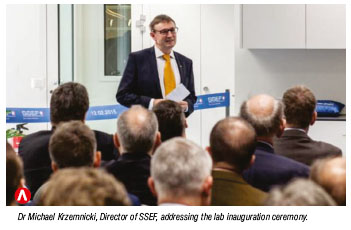 The Swiss Gemmological Institute (SSEF), one of the world's most respected gem research, education and grading institutions, has inaugurated a state-ofthe- art laboratory in Basel, more than doubling the size of its previous facility and enabling a massive expansion of the services it has provided the gemstone, jewellery and watch industries for more than 40 years. The 720 square-metre new home, located within eyesight of Basel's main railway station, is a significant upgrade from the 300- square metre laboratory that the organisation had occupied since 1994. Customised to facilitate the growth of SSEF's diamond, coloured gemstone and pearl grading and testing divisions, it also is designed to keep the organisation at the forefront of gemmological research, while at the same time expanding the educational services it provides the Swiss, European and international gem communities.The inauguration ceremony, which took place February 12, 2015, gathered at the new facility a select representation of the Swiss gem, jewellery and watch industries, as well as industry leaders who have travelled in from abroad. The Swiss Gemmological Institute (SSEF), one of the world's most respected gem research, education and grading institutions, has inaugurated a state-ofthe- art laboratory in Basel, more than doubling the size of its previous facility and enabling a massive expansion of the services it has provided the gemstone, jewellery and watch industries for more than 40 years. The 720 square-metre new home, located within eyesight of Basel's main railway station, is a significant upgrade from the 300- square metre laboratory that the organisation had occupied since 1994. Customised to facilitate the growth of SSEF's diamond, coloured gemstone and pearl grading and testing divisions, it also is designed to keep the organisation at the forefront of gemmological research, while at the same time expanding the educational services it provides the Swiss, European and international gem communities.The inauguration ceremony, which took place February 12, 2015, gathered at the new facility a select representation of the Swiss gem, jewellery and watch industries, as well as industry leaders who have travelled in from abroad.
Greeting the guests, SSEF's Director, Dr Michael Krzemnicki, described the organisation's transformation from a compact but highly respected Swiss laboratory into one of the world's leading gemmological authorities, with a team of 25 specialists. "When I started working at SSEF more than 16 years ago, we were a team of five staff members working in a rather small apartment in the centre of Basel, "here called." The atmosphere was quite family style, but also fascinating for me as a mineralogist, as we were testing highly prestigious gems and jewellery for the trade and auction houses, due to the international reputation of our expertise." Dr Krzemnicki paid tribute to his predecessors, George Bosshart, who served as SSEF director from 1974 to 1990, and Prof. Henry A. Hänni, who was director from 1990 to 2009 and who was present at the ceremony.
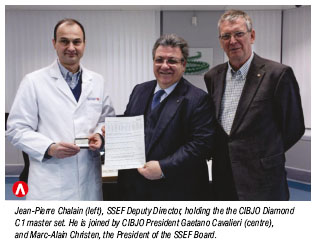 In his address, Marc-Alain Christen, the President of the SSEF Board, traced the growth of the organisation from a laboratory that focussed on the local market into one operates internationally. "Over the years the range of clients became strongly globalised," he said. "Frequent on-site testing in Hong Kong, Bangkok and Paris by SSEF specialists, as well as efficient and secure transportation of valuable items from all over the world to Basel have greatly contributed to the internationalisation of SSEF's work." From its very early days, SSEF has served as touch stone for the gemmological sciences. Not long after its establishment it was charged with the responsibility of being the custodian of the CIBJO Diamond C1 master set, and it has since served as the source for colour master sets used by diamond grading laboratories around the world. Present at the inauguration ceremony was CIBJO President Gaetano Cavalieri. In his address, Marc-Alain Christen, the President of the SSEF Board, traced the growth of the organisation from a laboratory that focussed on the local market into one operates internationally. "Over the years the range of clients became strongly globalised," he said. "Frequent on-site testing in Hong Kong, Bangkok and Paris by SSEF specialists, as well as efficient and secure transportation of valuable items from all over the world to Basel have greatly contributed to the internationalisation of SSEF's work." From its very early days, SSEF has served as touch stone for the gemmological sciences. Not long after its establishment it was charged with the responsibility of being the custodian of the CIBJO Diamond C1 master set, and it has since served as the source for colour master sets used by diamond grading laboratories around the world. Present at the inauguration ceremony was CIBJO President Gaetano Cavalieri.
"SSEF is a true gem in our trade, and an asset that needs to be valued and respected," he said. "What better manner to do that than the way we are doing it today. This is a facility from which not only SSEF, but also the entire the jewellery and gemstone business, will continue to draw strength for many years to come." SSEF's role as a service provider at the very highest echelons of the business was confirmed by the presence at the inauguration ceremony of representatives of the world's leading watch manufacturers, among them representatives of the Swatch group and the Richemont group, and also the auction houses, for whom SSEF has long provided expert grading services.
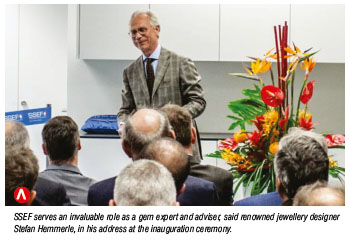 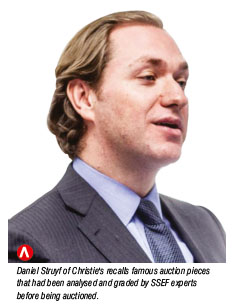
Addressing the gathering, Daniel Struyf of Christie's recalled several of the famous auction pieces handled by his company, which first had carefully been analysed and graded by SSEF experts before going on public sale. Stefan Hemmerle, a renowned jewellery designer, spoke of the intense and collaborative relationship that he developed with SSEF, which served him and his company as an advisor in matters related to gem identification and grading.
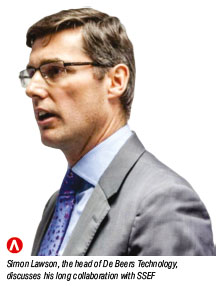 A highlight of the inaugural event was the public presentation of SSEF's Automated Spectral Diamond Inspection (ASDI) system, which analyses and measures large quantities of melee diamonds, smaller than 3.8 millimetres in diameter, filtering out simulants, possible synthetic diamonds and possible HPHT-treated diamonds. As the participants watched, the machine sorted through a batch of more than 1,400 small diamonds, examining each one individually and accurately separating only the suspect stones. Noting that he was long aware of ASDI's technical prowess, but this was the first time he had seen it in action, was Simon Lawson, the head of De Beers Technology. Throughout his long collaboration with SSEF, Dr Lawson said, "I have been constantly impressed with the lab's commitment to developing practical solutions for the challenges that face our industry." This commitment was summed up by Dr Krzemnicki during his address at the inauguration ceremony. "The trade is constantly challenged by new and difficult developments, and old values such a trust and confidence nowadays need a backup by an independent gemmological report," he said. "Thus it has been and will be our foremost mission to provide you with the best gemmological services, as a worldwide leader in gemstone and pearl testing, based on our three main pillars - a highly experienced team of scientifically educated gemmologists, state-of-the-art instrumentation, and continuous research to be able to answer all challenges the market is facing, today and tomorrow." A highlight of the inaugural event was the public presentation of SSEF's Automated Spectral Diamond Inspection (ASDI) system, which analyses and measures large quantities of melee diamonds, smaller than 3.8 millimetres in diameter, filtering out simulants, possible synthetic diamonds and possible HPHT-treated diamonds. As the participants watched, the machine sorted through a batch of more than 1,400 small diamonds, examining each one individually and accurately separating only the suspect stones. Noting that he was long aware of ASDI's technical prowess, but this was the first time he had seen it in action, was Simon Lawson, the head of De Beers Technology. Throughout his long collaboration with SSEF, Dr Lawson said, "I have been constantly impressed with the lab's commitment to developing practical solutions for the challenges that face our industry." This commitment was summed up by Dr Krzemnicki during his address at the inauguration ceremony. "The trade is constantly challenged by new and difficult developments, and old values such a trust and confidence nowadays need a backup by an independent gemmological report," he said. "Thus it has been and will be our foremost mission to provide you with the best gemmological services, as a worldwide leader in gemstone and pearl testing, based on our three main pillars - a highly experienced team of scientifically educated gemmologists, state-of-the-art instrumentation, and continuous research to be able to answer all challenges the market is facing, today and tomorrow."
|



 The Swiss Gemmological Institute (SSEF), one of the world's most respected gem research, education and grading institutions, has inaugurated a state-ofthe- art laboratory in Basel, more than doubling the size of its previous facility and enabling a massive expansion of the services it has provided the gemstone, jewellery and watch industries for more than 40 years. The 720 square-metre new home, located within eyesight of Basel's main railway station, is a significant upgrade from the 300- square metre laboratory that the organisation had occupied since 1994. Customised to facilitate the growth of SSEF's diamond, coloured gemstone and pearl grading and testing divisions, it also is designed to keep the organisation at the forefront of gemmological research, while at the same time expanding the educational services it provides the Swiss, European and international gem communities.The inauguration ceremony, which took place February 12, 2015, gathered at the new facility a select representation of the Swiss gem, jewellery and watch industries, as well as industry leaders who have travelled in from abroad.
The Swiss Gemmological Institute (SSEF), one of the world's most respected gem research, education and grading institutions, has inaugurated a state-ofthe- art laboratory in Basel, more than doubling the size of its previous facility and enabling a massive expansion of the services it has provided the gemstone, jewellery and watch industries for more than 40 years. The 720 square-metre new home, located within eyesight of Basel's main railway station, is a significant upgrade from the 300- square metre laboratory that the organisation had occupied since 1994. Customised to facilitate the growth of SSEF's diamond, coloured gemstone and pearl grading and testing divisions, it also is designed to keep the organisation at the forefront of gemmological research, while at the same time expanding the educational services it provides the Swiss, European and international gem communities.The inauguration ceremony, which took place February 12, 2015, gathered at the new facility a select representation of the Swiss gem, jewellery and watch industries, as well as industry leaders who have travelled in from abroad.

